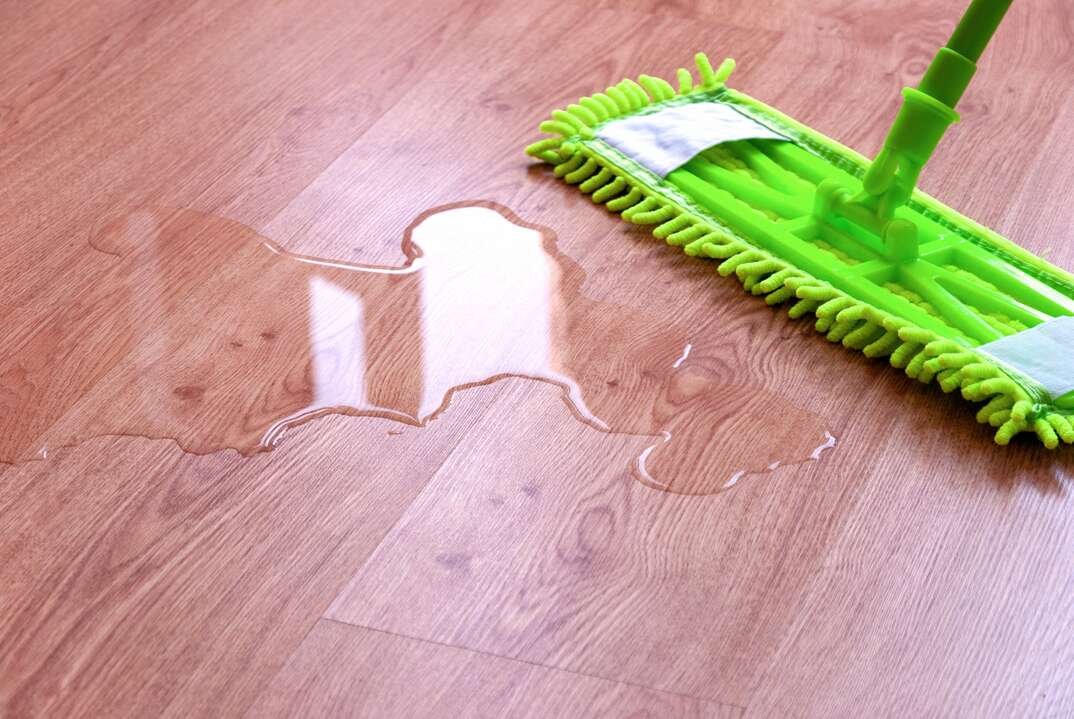How to Repair Your Water-Damaged Hardwood Floor

Hardwood floors are a popular and elegant flooring option — but there's a catch. Hardwood is vulnerable to water, and even small amounts can cause a lot of damage if you don't mop it up quickly.
However, don't despair if you've got a water-damaged hardwood floor. You can often repair water damage for significantly less than it would cost to start over with a brand-new floor.
How Long Does It Take for Water to Damage Hardwood Floors?
How long it takes water to damage hardwood floors depends on the location and scale of the leak or flood. Most hardwood floor surfaces are treated to help them withstand spills. A small amount of water spilled on the floor is usually nothing to worry about, although it's still best to mop it up as quickly as possible.
Major leaks around or under your hardwood floor are more of an issue because the water can seep into the cracks between the floorboards and soak into the wood. Water can damage wood irreparably in as little as 24 hours, so it's essential to dry your floor out immediately.
The first step to avoiding permanent wood floor water damage is to call a professional plumber to fix the leak as quickly as possible. Next, pull up any rugs or carpets covering the floor and mop up any visible water. If the flooding is extensive, you can use a wet vacuum cleaner to remove large amounts of water from your floor.
Finally, encourage the floor to dry out by placing a dehumidifier in the affected room and turning on your air conditioning. Fans can also stimulate airflow and help floors dry faster. Once your floor is dry, you can assess the damage to decide if a repair is possible.
Can Water-Damaged Wood Floors Be Fixed?
You can sometimes repair water-damaged floors, but whether it's possible depends on a few factors.
First, you need to assess the extent and severity of the damage. Mild damage over a small area is generally fairly simple to put right and far less disruptive than taking up the entire floor and starting again.
However, you'll also need to decide whether it's possible to replace the damaged boards and achieve a finish that matches the rest of the floor. Hardwood floor finishes tend to mature over time, so you may not be able to get the new boards the same color even if you use the same finishing treatment. Sometimes, you'll need to repair the damaged area and refinish the entire floor to get a consistent look.
If the floor was exposed to water over a long period, you may also have a damp subfloor. Crowning — where the middle of the board bulges upward — is also a sign of a damp subfloor and could indicate that it wasn't sealed correctly during installation. Repairing the hardwood without tackling the damp subfloor will lead to the problem reoccurring later on.
What Are Some Ways to Fix Buckled or Warped Hardwood Floors?
Sometimes, mildly warped or buckled wooden floor planks will return to their original shape if you allow them to dry out completely. Try dehumidifying the room for at least 24 hours to see if it solves the issue. You might also be able to place a heavy object or stack of books on buckled portions to straighten them back out.
However, water-damaged hardwood that's been soaking in water for some time is often impossible to repair without replacing the damaged floorboards. If only a couple of planks have been damaged, you can perform your own wood floor repair.
Begin by carefully removing the damaged planks with a pry bar to avoid damaging the neighboring boards. You could also use a circular saw to cut away a damaged section if some of the boards are partially salvageable. Cut a new plank to fit the hole and slide the tongue into the groove of the adjacent plank, nailing it in position. Ensure that the nail head sits below floor level.
Finally, apply wood putty to the join and scrape off the excess with a putty knife. You can now sand the new board and finish it to match the surrounding floor. Allow the finish to dry thoroughly before replacing your furniture.
At What Point Will You Need to Replace Your Floors?
You'll need to replace your entire floor if the water damage is extensive and there are simply too many unsalvageable boards for spot repairs to be practical. You should also consider replacing the entire floor if the water has penetrated through to the subfloor.
It's also important to consider the kind of water that caused the damage. You may be able to repair a water-damaged hardwood floor if the cause was a leak of clean water (straight from the tap) or gray water containing detergent or mild chemicals (such as from a washing machine or dishwasher leak).
However, you'll need to replace your floor if the damage is due to black water leaking from a sewer line or broken toilet. Unfortunately, you may also need to replace the subfloor. Black water contains hazardous bacteria, so it's essential to remove any contaminated planks as soon as possible.
Elocal Editorial Content is for educational and entertainment purposes only. Editorial Content should not be used as a substitute for advice from a licensed professional in your state reviewing your issue. Systems, equipment, issues and circumstances vary. Follow the manufacturer's safety precautions. The opinions, beliefs and viewpoints expressed by the eLocal Editorial Team and other third-party content providers do not necessarily reflect the opinions, beliefs and viewpoints of eLocal or its affiliate companies. Use of the Blog is subject to the
Website Terms and Conditions.The eLocal Editorial Team operates independently of eLocal USA's marketing and sales decisions.



